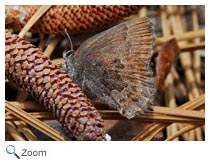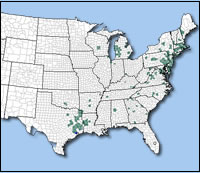Frosted Elfin Butterfly - Callophrys irus |
||||||||
Description
Range |
Habitat
The frosted elfin butterfly is found in oak savannah and pine barren habitats and open woods and forest edges with wild blue lupine. DietThe caterpillar of the frosted elfin butterfly eats wild blue lupine, but some populations of the caterpillar also eats wild indigo, blue false indigo, and rattlebox. Adult frosted elfin butterflies eat the nectar of a variety of flowers. LifecycleThe frosted elfin female lays her eggs in the spring on the flower buds of a host plant, usually wild lupine or false indigo. The chrysalis weaves a cocoon and ` in leaf litter under the host plant. The caterpillars eat the flowers and seedpods of the host plant. BehaviorThe frosted elfin is a poor flier. This, along with its dependence on lupine, may explain why its populations are isolated and scattered. |
|||||||


 The frosted elfin butterfly is found in scattered local communities from Maine west across New York and southern Michigan to central Wisconsin; south along the Atlantic coast and the Appalachians to northern Alabama and Georgia. There are isolated colonies in eastern Texas, northwest Louisiana, and southwest Arkansas. The frosted elfin butterfly is endangered in New Hampshire.
The frosted elfin butterfly is found in scattered local communities from Maine west across New York and southern Michigan to central Wisconsin; south along the Atlantic coast and the Appalachians to northern Alabama and Georgia. There are isolated colonies in eastern Texas, northwest Louisiana, and southwest Arkansas. The frosted elfin butterfly is endangered in New Hampshire.